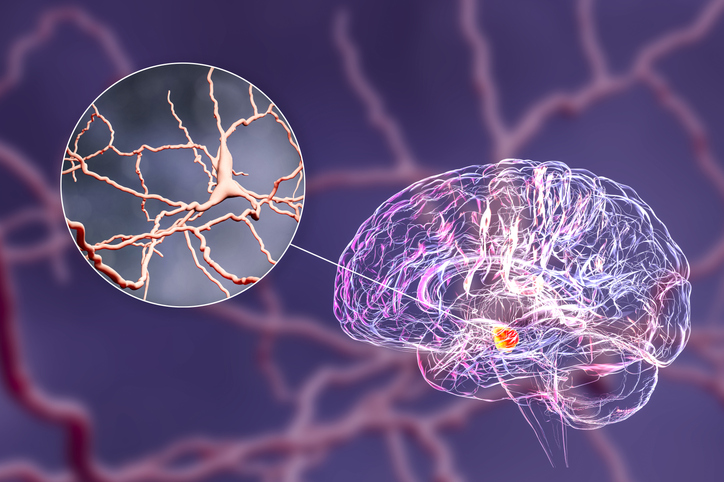What happens in the human brain when we learn from positive and negative experiences? To help answer that question and better understand decision making and human behavior, scientists are studying dopamine, a neurotransmitter produced in the brain that serves as a chemical messenger, facilitating communication between nerve cells in the brain and the body.
Dopamine is mostly associated with positive emotions, but the results of a study by researchers at Wake Forest University School of Medicine have shown that dopamine release in the human brain plays a crucial role in encoding both reward prediction errors (RPE) and punishment prediction errors (PPE). The investigators carried out subsecond measurements of dopamine release in the brains of human volunteers who were undergoing deep brain stimulation (DBS) surgery, while the individuals undertook a specific task. The findings indicate that dopamine in learning from both positive and negative experiences, allowing the brain to adjust and adapt its behavior based on experience outcomes.
“Traditionally, dopamine is often referred to as ‘the pleasure neurotransmitter,”’ said research lead Kenneth T. Kishida, PhD, associate professor of physiology and pharmacology and neurosurgery at Wake Forest University School of Medicine. “However, our work provides evidence that this is not the way to think about dopamine. Instead, dopamine is a crucial part of a sophisticated system that teaches our brain and guides our behavior. That dopamine is also involved in teaching our brain about punishing experiences is an important discovery and may provide new directions in research to help us better understand the mechanisms underlying depression, addiction, and related psychiatric and neurological disorders.”
Kishida and colleagues reported on their findings in Science Advances, in a paper titled “Subsecond fluctuations in extracellular dopamine encode reward and punishment prediction errors in humans.”
The neurotransmitter dopamine is involved in a range of functions, such as movement, cognition and learning, but abnormal dopamine activity may also underpin different diseases, the authors suggested. “Dopamine neurons are critical for mammalian brain function and behavior, with changes in dopaminergic efficacy believed to underlie a wide range of human brain disorders including substance use disorders, depression, and Parkinson’s disease,” they wrote.
Kishida explained that prior research had shown that dopamine plays an important role in how animals learn from “rewarding”—and possibly “punishing”—experiences. As the authors wrote. “In the mammalian brain, midbrain dopamine neuron activity is hypothesized to encode reward prediction errors that promote learning and guide behavior by causing rapid changes in dopamine levels in target brain regions.” Also, they noted, “ … human functional magnetic resonance imaging experiments suggest that RPE and punishment prediction error (PPE) signals are represented in dopamine-rich regions during learning about appetitive and aversive outcomes. But as Kishida also pointed out, “… little work has been done to directly assess what dopamine does on fast timescales in the human brain.”
For their newly reported study Kishida lab, and collaborators, utilized fast-scan cyclic voltammetry, an electrochemical technique, paired with machine learning, to detect and measure dopamine levels in real-time (i.e., 10 measurements per second). This method can only be performed during invasive procedures such as deep brain stimulation brain surgery. DBS is commonly employed to treat conditions such as Parkinson’s disease, essential tremor, obsessive-compulsive disorder and epilepsy.
Kishida’s team collaborated with Atrium Health Wake Forest Baptist neurosurgeons Stephen B. Tatter, MD, and Adrian W. Laxton, MD,—also both faculty members in the Department of Neurosurgery at Wake Forest University School of Medicine—to insert a carbon fiber microelectrode deep into the brain of three participants at Atrium Health Wake Forest Baptist Medical Center who were scheduled to receive DBS to treat essential tremor.

The participants, awake in the operating room, played a simple computer game. As they played the game, dopamine measurements were taken in the striatum, a part of the brain that is important for cognition, decision making, and coordinated movements.
During the game, participants’ choices were either rewarded or punished with real monetary gains or losses. “Optimal performance on this task requires participants to learn from positive and negative feedback to select the option on each trial that maximizes the expected reward and minimizes the expected punishment,” the investigators explained.
The game was divided into three stages in which participants learned from positive or negative feedback to make choices that maximized rewards and minimized penalties. Dopamine levels were measured continuously, once every 100 milliseconds, throughout each of the three stages of the game.
“This is the first study in humans to examine how dopamine encodes rewards and punishments and whether dopamine reflects an ‘optimal’ teaching signal that is used in today’s most advanced artificial intelligence research,” Kishida said. “We found that dopamine not only plays a role in signaling both positive and negative experiences in the brain, but it seems to do so in a way that is optimal when trying to learn from those outcomes.”
The authors further noted, “Collectively, our results suggest that human decision-making is influenced by independent, parallel processing of appetitive and aversive experiences and expectations that can affect modulation of dopamine release in striatal regions on rapid timescales (hundreds of milliseconds).”
Kishidi added, “What was also interesting, is that it seems like there may be independent pathways in the brain that separately engage the dopamine system for rewarding versus punishing experiences. Our results reveal a surprising result that these two pathways may encode rewarding and punishing experiences on slightly shifted timescales separated by only 200 to 400 milliseconds in time.”
The investigator believes that this level of understanding may lead to a better understanding of how the dopamine system is affected in individuals with psychiatric and neurological disorders. As the team stated, “… it has not escaped our notice that the PPE aversive learning system has features that suggest a role in anxiety disorders analogous to models of the RPE reinforcement learning system role in addiction, depression, and obsessive-compulsive disorder.” However, additional research will be needed to understand how dopamine signaling is altered in such conditions.



